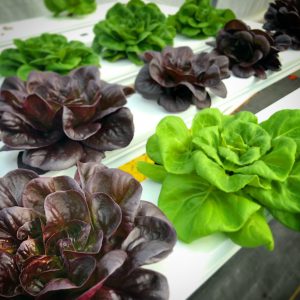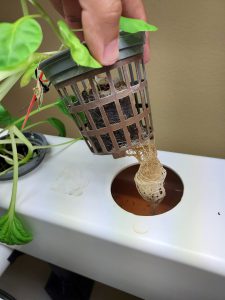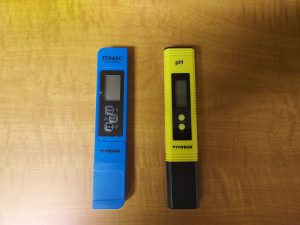
Each year we have less agricultural land available, making it more difficult for farmers to acquire land to grow crops due to urban development increases in Florida.
From 2010 to 2019, Florida’s population grew 14.2% to become the third most inhabited state in the United States (US Census 2019). This challenge, in combination with the growing home food production trend, makes alternative ways to produce fruits and vegetable enticing. One of the alternatives urban farmers and gardeners have to grow crops is the use of hydroponics systems.
What is a Hydroponic System?
By definition, the term “hydroponic” means water working. Today, this term is used to describe the culture of growing plants without soil. It is a known fact that plants use the soil in order to anchor themselves for structural support and to absorb nutrients present in it. In a hydroponic systems the physical support can be replaced with substrates, and the nutrients can be supplied through a water solution. To simplify this concept, hydroponic production replaces the function of soil for plants when compared with conventional agricultural growing systems.
Some Advantages of Hydroponic Systems Compared with Conventional Farming are:
- Soil substitution and less use of pesticides—No soil is required for the system to work properly. Also no soil means little concern for unwanted weeds, reducing the use of pesticides.

Root development in a NFT Hydroponic system. Photo by: Luis O. Rodriguez, UF/IFAS Extension, Polk County. - Require less space—You can increase crop per growing area. Some hydroponic systems can be stacked on top of each other duplicating the yield if properly designed and managed.
- Potential to grow indoors or in limited spaces—You can place a hydroponic inside a building. This can also help to avoid certain pest problems. Also you can produce crops with a hydroponic system in a field, residence, greenhouse, or farm.
- Minimize the risk of soilborne pathogens—No soil means no root-knot nematodes and less risk of bacterial or fungal diseases.
- Control of nutrients—Since your are adding nutrients into the system, you can manipulate the amount of nutrients desired.
Some Disadvantages of Hydropic System Compared to Conventional Farming are:
- High investment cost—In comparison to conventional agriculture the investment costs are higher because of the materials and energy needed to built a hydroponic system.
- Crop limitations—Depending on the hydroponic system, some tall crops are difficult to grow. For example, in an NFT hydroponic, crops such as corn, tomatoes, and sunflowers are not recommended.
Nutrient Film Technique (NFT)
The Nutrient Film Technique (NFT) is a hydroponic system that recirculates a nutrient solution across all the plants in the growing channels using PVC piping as the distribution mechanism. This method is one of the most popular hydroponic systems used in commercial agriculture. This type of system is suitable outdoors, indoors, or in a greenhouse setting. Some of the crops suitable to grow using this type of hydroponic method are herbs, leafy greens, strawberries, and other low growing and short-term crops. The NFT system requires electricity to run a pump in order to recirculate the nutrient solution throughout the growing channels. An NFT system can be bought as a prefabricated system or farmers can build their own.
Tools required for a NFT hydroponic system:

- Support system—A structure where you are going to placed your hydroponic system (It could be made using PVC pipes)
- Tank—To store the water that is going to be use.
- Pump—To distribute the water across the system.
- PVC piping and channels—Piping will be use to place the plants and also to distribute the water with the nutriment solution.
- Lighting (indoors)—These could be UV lights or fluorescence lights
- Plant pots—To place the plants across the PVC piping.
- Substrate (or media)—Could be coconut fiber, rock wool, perlite.
- Timers—For both lighting and water pump.
- pH and conductivity meter—Monitor water quality (nutrient solution).

(THIS PHOTO IS FOR EDUCATIONAL PURPOSES, NO BRAND IS BEING PROMOTED IN THIS PUBLICATION)
Conclusion:
Growing crops in a hydroponic system is an alternative for farmers with space limitations. The NFT hydroponic systems is one of the most popular designs due its simplicity and good performance.
For more information about hydroponics,
Go to these ask IFAS publications:
Growing Lettuce in Small Hydroponic Systems
Leafy Greens in Hydroponic and Protected Culture For Florida
Or watch these videos:
Hydroponics water solutions
Growing Media for Hydroponics Systems
Authors: Rodriguez, UF/IFAS Polk County, J. Bosques UF/IFAS Hardee County
University of Florida is an equal opportunity institution
Source: UF/IFAS Pest Alert



